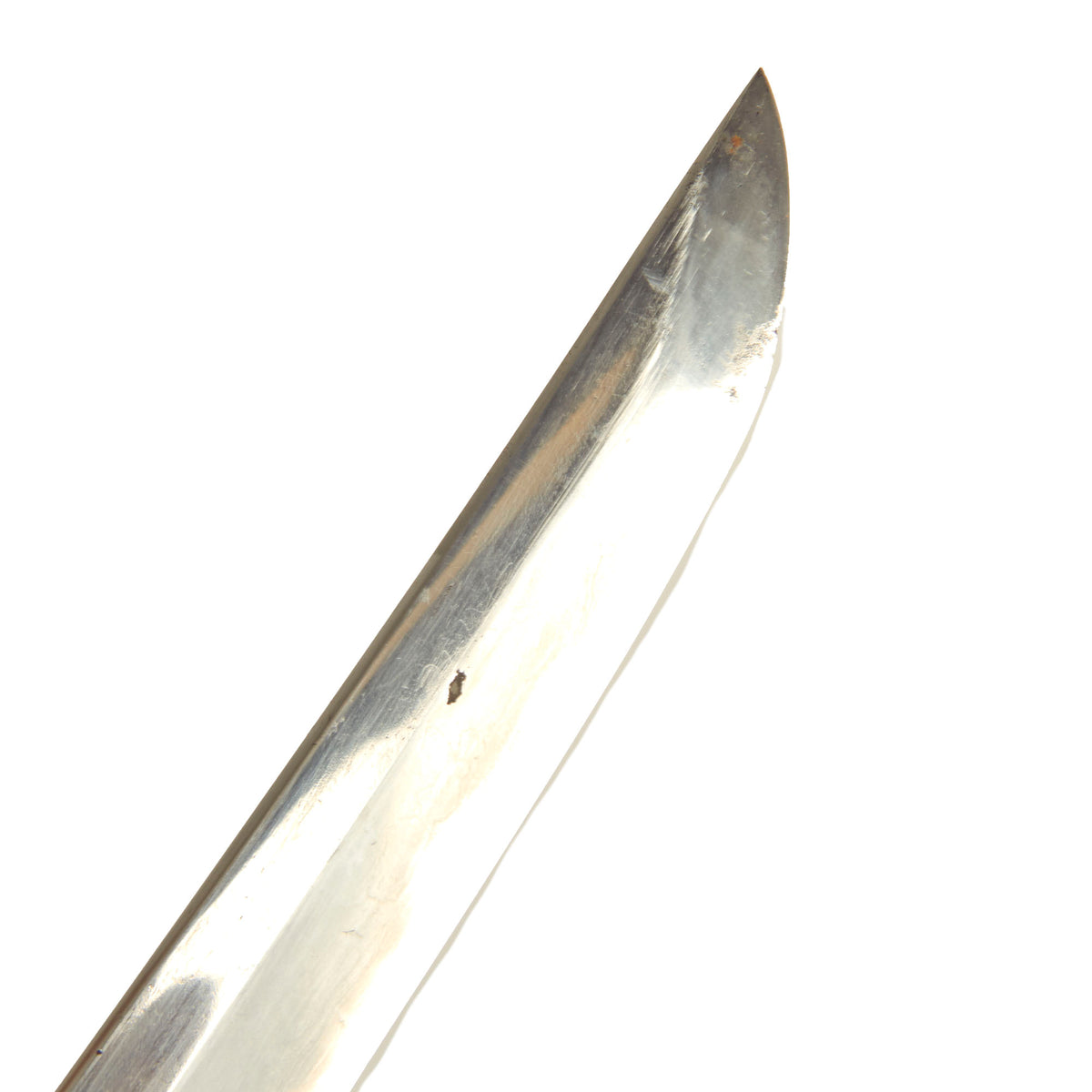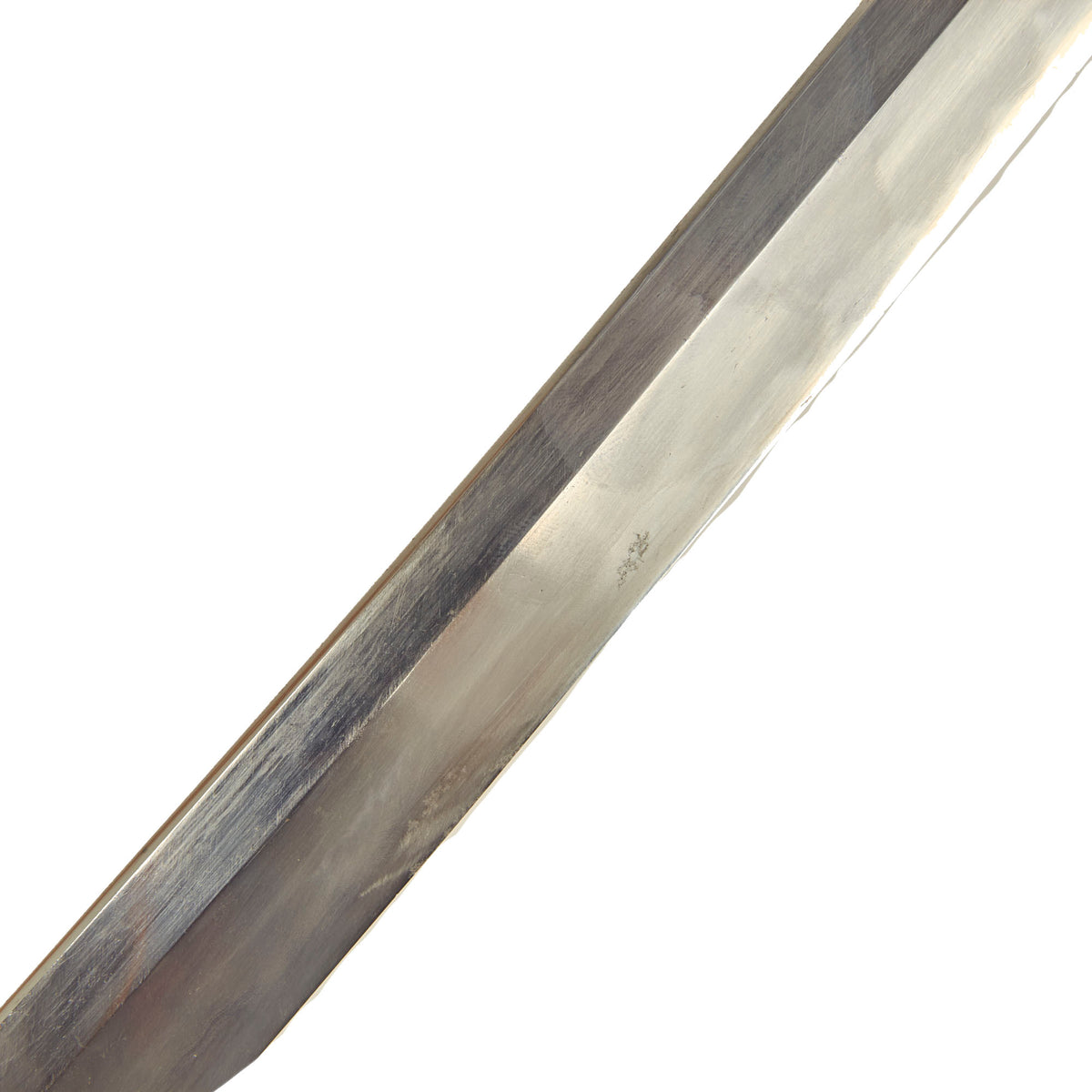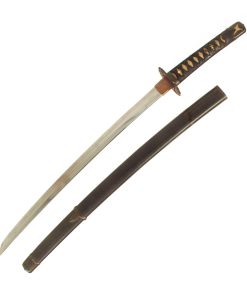Original Edo Period Japanese Handmade Wakizashi Short Sword in Handachi Mountings with Lacquered Scabbard Original Items
$ 1.995,00 $ 498,75
Original Item: Only One Available. Wakizashi (脇差 “side inserted / companion sword”) is a general term for a sword with an edge between one and two shaku long (30 cm and 60 cm), predominantly made after 1600. Generally it is the short blade that accompanies a katana in the traditional samurai daisho pairing of swords, but may be worn by classes other than the samurai as a single blade, also worn edge up as the katana.
This example dates from the Edo period (江戸時代, Edo jidai) or Tokugawa period (徳川時代, Tokugawa jidai) of Japanese history. This is the period between 1603 and 1867, when Japan was under the rule of the Tokugawa shogunate and the country’s 300 regional daimyo. As the blade length is close to that of a Katana, and the blade is the “Shinogi-Zukuri” shape, some would term this an “O-Wakizashi”.
This example has most likely been remounted several times, as was common for Japanese blades. This has made the file marks (yasurimi) on the tang faint, and given it a lovely patina. There is also some patinated oxidation, a sign of great age. As there is no maker name on the tang, this blade is considered 無名 (mumei), or “anonymous”.
Currently, the wakizashi is in HANDACHI KOSHIRAE (半太刀拵え), which are a set of fittings in the old Japanese TACHI (太刀) style, when used on a shorter sword such as a katana or wakizashi. This is a lovely and classic style, and one of the first times we have had a wakizashi in this style of fittings.
The blade has the following period correct features:
– Folded steel blade (fold lines are evident on the spine and body of the blade)
– Hole (mekugi-ana) in the tang is punched and not drilled
– Blade has a temper line (hamon), which is a bit faint but still distinct.
– Blade wounds (kizu) or lamination artifacts are present on the blade. Both ware (lamination lines) and fukure (carbon pits) are visible.
– Blade has a bo’hi fuller, which is properly executed and helps to lighten the blade.
The blade of this example is 20 5/8 inches long, and the polish is in very good condition, though it has been cleaned a bit, which has made some aspects of the blade a bit faint. They are however still visible in the light, and it is still VERY sharp, and should be handled with care. Overall length of this wakizashi is 29 1/4 inches. The tang of the blade (中心 – nakago) is of the futsu (普通 – regular) style, with a Haagari (asymmetrical rounded) nakago-jiri.
The hamon (刃文 – temper line) is still visible in the light, and is of the HAKO MIDARE (箱乱 – uneven box shape) type, which is definitely one of the more rare types that se see. We can still easily see NIE crystallization, with the NIOI cloudiness in the hamon. There is definitely lots of activity along the transition to the hamon. The YOKOTE (横手) is still faintly visible, and the BOSHI (帽子 – tip temper line) is of the OOMARU (large turnback) type. There are blade wounds including ware (lamination splits) and fukure (Carbon pits). The sword has a copper Habaki (blade collar), which is typical of the Edo period. Definitely a nice Edo period blade with some great aspects to enjoy.
The TSUBA (鍔 -cross guard) is made of well-patinated iron and is of the lovely AOI GATA shape, with embossed designs on both sides, as well as heart-sharped perforations at the corners. There are two HITSU-ANA (櫃穴) holes in the guard, one for the KOGAI hair pin and the other for a KOZUKA accessory knife handle. There are 3 copper SEPPA (spacers) around the tsuba, used to help stabilize the guard, which does wobble a bit at present.
The FUCHI (grip collar) for the TSUKA (柄- handle) are both “rain” textured brass, as is the KABUTO-GANE (pommel cap), which are definitely a matching set. The stingray skin (SaMe) grip is in great shape, and is wrapped with a nice black ITO fabric wrapping. There is some wear and fraying, which looks to have been repaired long ago. There are two bronze menuki grip ornaments present, which look to be samurai images. They have gilt highlights and look great.
The sword comes in a a well fitting textured black lacquer wooden scabbard (SAYA), which has an accessory slot on one side, probably for a KOGATANA knife, which is unfortunately missing. The other side has a KURIKATA (knob) with a SHITODOME ornamental fitting inside, which would be used for a SAGEO sword cord (not present). The scabbard is in very good condition, with very little missing finish, and no splitting along the seams. The KOIGUCHI (scabbard mouth) is fit with brass textured like the fuchi, and SEMEGANE scabbard ring and large SAYAJIRI scabbard drag made from the same material. Really a lovely scabbard!
A lovely Edo Period O-Wakizashi, complete with some great Handachi fittings and ready to display!
Specifications:
Blade Length: 20 5/8″
Blade Shape: Shinogi-Zukuri
Overall length: 29 1/4“
Scabbard Length: 22 3/4″
It has been over one thousand years ago that the art of making swords appeared in Japan. The swordsmiths of the time may not have known it but they were creating a legendary sword. The Samurai sword has seen combat in many battlefields. From the early days of the Samurai warrior to the fierce battles in the South Pacific during WWII.
Each hand-made Japanese blade (日本刀 – Nihonto) is unique because it is forged from multiple pieces of folded steel stock. A tremendous amount of work is dedicated to creating these pieces. They were an instrument of war as much as a beautiful artifact to adorn a room.
The traditional Japanese blade and mountings have grown to be one of the most highly desired military antiques.
Fast Shipping with Professional Packaging
Thanks to our longstanding association with UPS FedEx DHL, and other major international carriers, we are able to provide a range of shipping options. Our warehouse staff is expertly trained and will wrap your products according to our exact and precise specifications. Prior to shipping, your goods will be thoroughly examined and securely secured. We ship to thousands clients each day across multiple countries. This shows how we're dedicated to be the largest retailer on the internet. Warehouses and distribution centres can be located throughout Europe as well as the USA.
Note: Orders with more than one item will be assigned a processing date depending on the item.
Before shipping before shipping, we'll conduct a thorough inspection of the items you have ordered. Today, the majority of orders will be delivered within 48 hours. The delivery time will be between 3-7 days.
Returns
The stock is dynamic and we cannot completely manage it because multiple stakeholders are involved, including our factory and warehouse. So the actual stock may alter at any time. It's possible that you may not receive your order once the order has been made.
Our policy is valid for a period of 30 days. If you don't receive the product within 30 days, we are not able to issue a refund or an exchange.
You can only return an item if it is unused and in the same state as the day you received it. You must have the item in its original packaging.
Related products
Uncategorized
Uncategorized
Band of Brothers ORIGINAL GERMAN WWII Le. F.H. 18 10.5cm ARTILLERY PIECE Original Items
Uncategorized
Uncategorized
Uncategorized
Uncategorized
Armored Burgonet Helmet & Polearm from Scottish Castle Leith Hall Circa 1700 Original Items
Uncategorized
Uncategorized
Uncategorized
Uncategorized
Uncategorized
Uncategorized
Uncategorized













































































